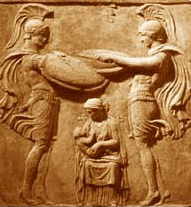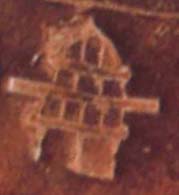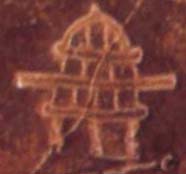Unpacking and publishing the Phaistos Disk since 1993
HOME | PREVIOUS | NEXT | SITEMAP

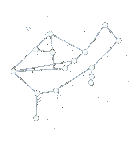
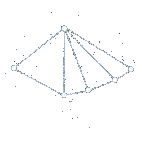


![]() Long after the Phaistos
Disk was created, the Greeks gave the name Helios to the god of the measurement of time. He had several sister goddesses called Horai.
(right) They were goddesses of the cycles of Time, presiding over the revolution of the circling constellations by
which the year was divided and measured. They were honored by farmers, who would hoe the ground, plant and tend their crops according to
the location of the stars in the skies. (The Horai, right, hold pomegranates/stars, and left on the disk.) The
passing seasons were measured by the position of the stars. Because the Horai surrounded and attended the throne of Helios, this method of
timekeeping is a heliocentric horai-scope or horoscope, meaning to observe time or the seasons.
Long after the Phaistos
Disk was created, the Greeks gave the name Helios to the god of the measurement of time. He had several sister goddesses called Horai.
(right) They were goddesses of the cycles of Time, presiding over the revolution of the circling constellations by
which the year was divided and measured. They were honored by farmers, who would hoe the ground, plant and tend their crops according to
the location of the stars in the skies. (The Horai, right, hold pomegranates/stars, and left on the disk.) The
passing seasons were measured by the position of the stars. Because the Horai surrounded and attended the throne of Helios, this method of
timekeeping is a heliocentric horai-scope or horoscope, meaning to observe time or the seasons.
 This method of keeping "star" time might point to the Sothic calendar, a wide-spread
Egyptian method of keeping time by tracking the star Sirius instead of the sun. The identical shield pictographs, also on side 1,
(left) when connected with lines reveal a pentagram inside a heptagram, perhaps the star Sirius surrounded by the seven planets.
This might strongly indicate the Minoan use of a Sothic calendar.
This method of keeping "star" time might point to the Sothic calendar, a wide-spread
Egyptian method of keeping time by tracking the star Sirius instead of the sun. The identical shield pictographs, also on side 1,
(left) when connected with lines reveal a pentagram inside a heptagram, perhaps the star Sirius surrounded by the seven planets.
This might strongly indicate the Minoan use of a Sothic calendar.
If the two sides of the Phaistos Disk have application as Minoan integrated calendars, taken together they might be a Lunisolar calendar with 12 months and, every two years, the periodic intercalation of a 13th month, the interlinking line segments. Side 1, the solar calendar, keeps track of the three seasons, each of four months duration, along the 12 line segments of the outer edge. A count of the daylight hours or divisions of each day could also be kept on this side of the disk, counting 12 divisions/hours along the outside edge with the 12 months and the seasons of the year.
Side 2, the lunar calendar, keeps time in lunar months (moonths), a moonth being the time between each of the four phases of the moon - new, waxing, full and waning. The lunar calendar has 12 moonths of 30 days for a 360-day year. The first moonth and new year might begin in the summer on the heliacal rising of star Sirius in 1600 BCE, approximately the equivalent of our July 1. (Alternately, the Minoans may have had 30 months of 12 days – the 30 line segments each side, 12 of them on the outside spiral. Every two years the 13th month would occur and it would be only 2 days shorter than the others.)
The combined Lunisolar calendar might have worked this way; one month solar, one month lunar, moving from to side to side of the disk, until 24 months had passed, at which time the intercalary or 13th month would begin the biennial festival of Dionysis in Minoan Crete in which the drama of his life was re-enacted. If the Phaistos Disk was mass produced during its time then it might have been widely distributed and used as a convenient calendar. Claire Grace Watson's solutions are ASTRONOMICAL interpretations. (Various Topics)
Side 2 might also contain a zodiac stellar calendar based on star groups. The star groups might be arranged in groups of 12,
along the outer edge in the same location as the lunar months. These might be the 12 constellations we are familiar with today, which come to us from
Greece, and also would include 18 more spiraling out from the center of Side 2, for a total of 36 groups or decans, each one rising above the dawn
horizon for 10 days, totaling 360 days. On Side 2, the star groups spiral into the center as they begin their move into the underworld of Tartarus/Hades
(go below the horizon) for 70 days/signs before they appear again.
With the addition of a 10 day intercalary month every two years, a 365-night stellar year can be accounted for. Observation of the
movement of star groups would let the Minoans tell time at night because the decans would rise 40 minutes later each night. When reckoning time at
night, only 12 decans (and annual divisions) were used (our signs of the zodiac), although 18 were taken into account, those in the center of the
disk, Side 2.
Set all the calendars to the first sighting of Sirius each year to keep them current. The Sothic (Sirius) year lasted from one
sighting of Sirius in the dawn of a new year until the next year on the same day. With these calendars working together, with Oceanus (the wave
spirals below) connecting all these calendars together, and thus all time, in a neverending wave spiral, infinity is accounted for, and this may
account for the infinity symbol created by interlocking both sides of the disk and also may indicate the symbolic meaning of the Minoan wave spirals in art. When did the first concept of infinity occur to us collectively? Perhaps it was during the Minoan civilization.
The integrated calendars may not have worked this way, but if we wanted to keep time in all these different ways we could if we
had the Phaistos Disk. Another calendar possibility would be a Minoan Sothic Calendar with a 366-day year.
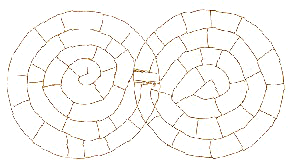
Sothic is the Greek word for Sirius, which the Egyptians called Sopdet or Sopdu. A Minoan calendar/Phaistos Disk would be unique in that it may have solved the problem of keeping accurate time when tracking star Sirius.
Sirius rises with the sun on about the same day every year, July 19th. Just like we add one day in February every leap year to make our calendar and our sun work in conjunction, the Egyptians added 5 days at the end of their year and tracked the movement of a star rather than the sun. The star's movement is so close to that of the sun that the star calendar worked the same as a sun calendar. One is a lunar calendar and the other is a solar calendar. And just like night follows day, the Egyptians and perhaps the Minoans had calendars with solar months and lunar months.
All Sothic calendars were known to have 12 months of 30 days. Some Sothic calendars may have had 30 months of 12 days. That presented the timekeepers with a problem -- a year of 360 days -- so they had to add 5 days at the end of the year to have a 365-day year so that the calendar would work right.
The Egyptians had a whole mythology that went with these 5 extra days, which were festival days in Egypt and perhaps Crete, when the birth of these gods was celebrated. With the extra 5 days added, the Egyptian Sothic calendar would start again the following year on or about the same important day -- the heliacal rising of Sirius -- July 19th or 20th, the day the star first rises with the sun. But the Sothic cycle was 1468 years because that is how long it takes for the calendar to recoup that day that was lost every 4 years from having a 365 day year.
How the Phaistos Disk comes into it is this: the Phaistos Disk may be a Sothic calendar that keeps accurate star time, and it may be the only physical one in existence. There may be something unique about this Sothic calendar. Instead of having 12 months of 30 days, it may have alternating months of 30 and 31 days, (counting the connecting line segment as a day of the month rather than an intercalary month) more like our calendar than like the Egyptian calendar. Around the outside edge of the disk are the 12 solar and the 12 lunar months. This is how one knows which month we are in when using this calendar. The solar months have 31 days and the lunar months have 30 days. The 2-sided disk/calendar represents a two-year period, at the end of which was held the festival of Dionysis in which his life was celebrated.
This method of keeping time is incredible if you consider what is known about Sothic calendars. It means that the Minoans may have figured out how to adjust a Sothic calendar so it kept proper star time and avoided the "Sothic cycle" of 1468 years.
Claire Grace Watson vs. Dr. Jerome Eisenberg in Japanese, as written and presented by (Urashima History and Archaeology)
If you look at our calendar you see something odd about it. The months don't alternate 30 and 31 days
every time, and February has only 28 days. Then, every four years we add a day to make up for the fact that our year is really 365 and 1/4 days,
and that ends our cycle. But since our sun rises each and every day and since our calendar is only off by a 1/4 of a day each year, we are
unaffected by that as long as we correct periodically.
The Minoans may have taken exactly the same approach. The difference is, while the Egyptians had years of 360 days and we have years
of 365 days, the Minoans may have had years of 366 days. Rather than add 5 days at the end of the year and then have a calendar that rights itself
every 1468 years, the Minoans may have had alternate months of 30 and 31 days, and then they subtracted a day at the end of every two years. That kept them
within a 1/2 day of accuracy. The heliacal rising of Sirius would always occur for them on or about July 1. At the end of 4 years they subtracted
2 days, and that ended their cycle. Their lunar months of 30 days followed their solar months of 31 days. Then, instead of adding 5 festival days at the
end of the year, like the Egyptians and their civil calendar, they celebrated them as festival days that occurred for them at the beginning of their
year with the heliacal rising of Sirius, and every 2 years they held the festival of Dionysis.
By this subtraction method of timekeeping, the Minoan calendar was simple and correct. This would have given them a huge
advantage over the rest of the Aegean world and would explain in part their fantastic civilization. Their calendar was always a little ahead
instead of a lot behind. Additional to their world-view might have been this grand idea that when we control Time, we control our destinies and even reinvent the world.
What a lovely website! (Lightworker8)
As you have observed, the pictographs on the disk are so tiny they appear to be identical. Therefore, an assumption was made and widely accepted for 100 years by all who study the disk that the pictographs were made with tiny stamps pressed into the clay disk. The would be an early printing press technology in the form of tiny pre-made stamps. The pictographs make the disk itself into a kind of stamp.
Here is another theory that became widespread when somebody looked at the disk and started guessing without analysis involved, so the theory is incorrect. All that's required is to enlarge the disk, crop the pictographs, place them side-by-side and compare.
If the artist had the idea and the knowledge to create unique stamps, then obviously s/he would have done so, if for no other reason than to make the pictographs truly identical and
also to save a monumental amount of time. Therefore, printing press technology in the form of tiny stamps into clay was not known at this time or, if it was known, this particular artist did not know it.
There is also the possiblity that the stamp technology was known but did not work well impressed into clay.
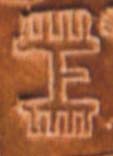
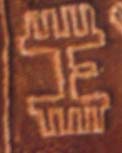 The printing press theory of using tiny stamps to the create the disk is incorrect.
Nor did the stamp theory ever explain the presence of the spirals on both sides of
the disk. The pictographs left, cropped from an enlarged bmp image of the disk, show the pictographs were intended by its creater to appear to be
identical but are not absolutely identical because the disk creator lacked the rudimentary printing press technology that has long been ascribed to the creation of the Phaistos Disk.
The printing press theory of using tiny stamps to the create the disk is incorrect.
Nor did the stamp theory ever explain the presence of the spirals on both sides of
the disk. The pictographs left, cropped from an enlarged bmp image of the disk, show the pictographs were intended by its creater to appear to be
identical but are not absolutely identical because the disk creator lacked the rudimentary printing press technology that has long been ascribed to the creation of the Phaistos Disk. ![]()
![]() As the
disk is only a little larger than a CD, the pictographs on the disk are tiny. When these two pictographs are reduced to a size that might appear on the disk, they do become "identical." But when they are enlarged they obviously match but are not identical. Although photographs of the disk make the pictographs appear to be raised, each pictograph was etched into the clay by hand and is recessed.
As the
disk is only a little larger than a CD, the pictographs on the disk are tiny. When these two pictographs are reduced to a size that might appear on the disk, they do become "identical." But when they are enlarged they obviously match but are not identical. Although photographs of the disk make the pictographs appear to be raised, each pictograph was etched into the clay by hand and is recessed.

 I cropped all the pictographs on the disk and checked them to see that not a single one of them is identical to another. Obviously, a very good artist created these pictographs and this disk. Only a good artist working in the genre of miniature art could create 240 individual pictographs to appear to be identical, but I include only a few here. It is very likely the artist excelled in the genre of miniature art during the Minoan period where art miniaturization was so very popular.
I cropped all the pictographs on the disk and checked them to see that not a single one of them is identical to another. Obviously, a very good artist created these pictographs and this disk. Only a good artist working in the genre of miniature art could create 240 individual pictographs to appear to be identical, but I include only a few here. It is very likely the artist excelled in the genre of miniature art during the Minoan period where art miniaturization was so very popular.
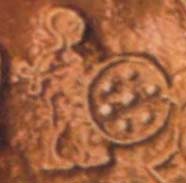 The Phaistos Disk is a pottery art masterpiece and an artist's triumph in the genre of miniaturization. Not only the pictographs are miniatures but also the disk itself, intended perhaps to be a miniature Figure 8 shield. Each side of the disk is a face of the shield, upper and lower, and on both faces are more designs so that the Figure 8 shield is a world disk in miniature. It might even have been the origin of the myth of Atlas, who may have started out in Minoan Crete carrying the world on his back as a shield and then, through transformation of the myth, eventually carried the world on his shoulders. (Below, warriors with Figure 8 shields on their backs attending the mother goddess and child)
The Phaistos Disk is a pottery art masterpiece and an artist's triumph in the genre of miniaturization. Not only the pictographs are miniatures but also the disk itself, intended perhaps to be a miniature Figure 8 shield. Each side of the disk is a face of the shield, upper and lower, and on both faces are more designs so that the Figure 8 shield is a world disk in miniature. It might even have been the origin of the myth of Atlas, who may have started out in Minoan Crete carrying the world on his back as a shield and then, through transformation of the myth, eventually carried the world on his shoulders. (Below, warriors with Figure 8 shields on their backs attending the mother goddess and child)